Peugeot 1007 2006 Owner Manual
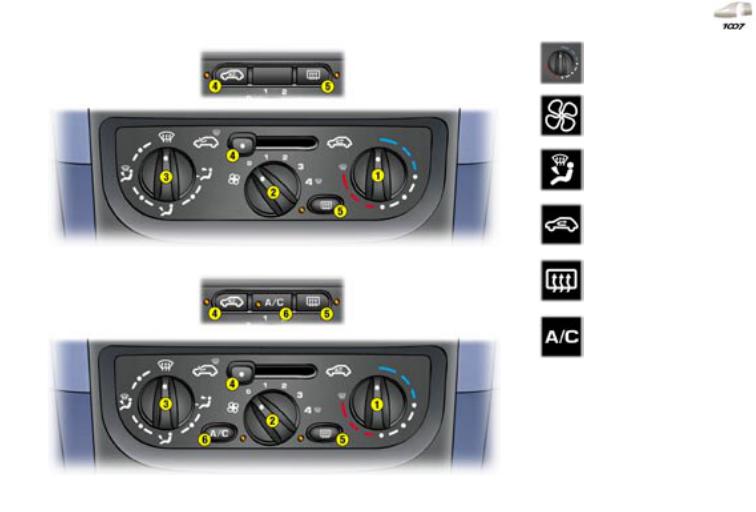
10 - Familiarisation
|
1. |
Temperature |
|
|
adjustment. |
|
2. |
Air flow adjustment. |
|
3. |
Air distribution |
|
|
adjustment. |
|
4. |
Air intake/Air |
|
|
recirculation. |
HEATING |
: 86 |
Rear screen and |
|
5. |
|
|
|
exterior mirrors |
|
|
demisting. |
|
6. |
Air conditioning on/off. |
MANUAL AIR CONDITIONING |
: 88 |
 01-10-2005
01-10-2005
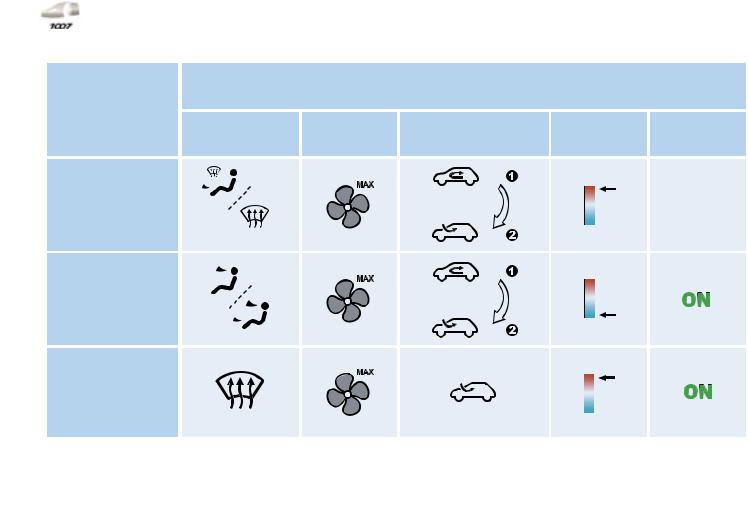
Familiarisation - 11
RECOMMENDED INTERIOR SETTINGS
|
Heating or Manual air conditioning |
|
||
I require... |
|
|
|
|
Air distribution |
Air fl ow |
Air recirculation/Intake |
Temperature |
Manual AC |
|
|
of exterior air |
|
|
HOT
COLD
DEMISTING
DE-ICING
 01-10-2005
01-10-2005

100 - Comfort
GENERAL POINTS RELATING TO CHILD SEATS
Although one of PEUGEOT's main criteria when designing your vehicle, the safety of your children also depends on you.
For maximum safety, please follow these precautions:
-since 1992, and in accordance with Directive 2000/3, all children under the age of 12 must travel in approved child seats* suited to their weight, on seats fitted with a seat belt or ISOFIX mountings**.
-statistically, the safest seats in your vehicle for the transportation of children are the rear seats,
-a child weighing less than 9 kg must travel in the "rearwardsfacing" position both in the front and in the rear.
PEUGEOT recommends that children should travel in the rear seats of your vehicle:
-"rearwards-facing" up to the age of 2,
-"forwards-facing" over the age of 2.
 01-10-2005
01-10-2005
INSTALLING A CHILD SEAT USING A THREE POINT SEAT BELT
"Rearwards-facing"
When a "rearwards-facing" child seat is installed on the front passenger seat, it is essential that the pas-
senger air bag** is disarmed. Otherwise, the child would risk being seriously injured or killed if the air bag were to inflate.
*According to current legislation in the country.
**According to model.
"Forwards-facing"
When a "forwards-facing" child seat is installed on the front passenger seat, adjust the vehicle's seat to the intermediate longitudinal position with the seat back upright and leave the passenger air bag armed**.
Intermediate longitudinal position
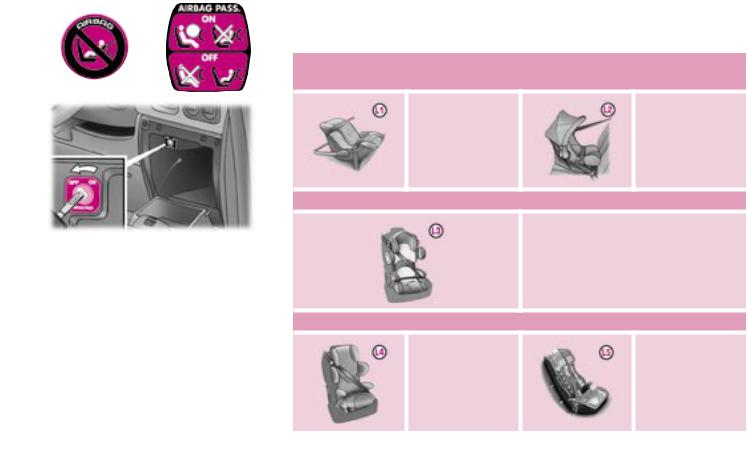
Comfort - 101
CHILD SEATS RECOMMENDED BY PEUGEOT
PEUGEOT offers a complete range of recommended child seats which are secured using a three point seat belt:
Group 0: from birth to 10 kg
Group 0+: from birth to 13 kg
L1 |
L2 |
"BRITAX |
"ROMER |
Babysure" |
Baby-Safe" |
(E11 0344117) |
(E1 03301146) |
Installed in the |
Installed in the |
rear-facing |
rear-facing |
position. |
position. |
Groups 1, 2 and 3: from 9 to 36 kg
L3 Passenger air bag OFF** "KIDDY Life"
(E1 03301135)
For the safety of young children (from 9 to 18 kg), PEUGEOT recommends use of the restraining cushion.
Groups 2 and 3: from 15 to 36 kg
|
L5 |
|
|
"KLIPPAN |
|
L4 |
Optima" |
|
(E17 030007) |
||
"RECARO Start'' |
||
From the age of |
||
(E1 03301108). |
||
6 years (approximately |
||
|
22 kg), the booster is |
|
|
used on its own. |
**According to version.
 01-10-2005
01-10-2005

102 - Comfort
INSTALLING CHILD SEATS SECURED USING THE SEAT BELT
In accordance with the European regulation (Directive 2000/3), this table indicates the options for the installation of child seats secured using the seat belt and universally approved in accordance with the weight of the child and the seat in the vehicle.
|
|
Weight of the child/indicative age |
|
||
Seat |
Below 13 kg |
From 9 to 18 kg |
From 15 to 25 kg |
From 22 to 36 kg |
|
|
groups 0 (a) and 0+) |
(group 1) |
(group 2) |
(group 3) |
|
|
Up to ≈ 1 year |
From 1 to ≈ 3 years |
From 3 to ≈ 6 years |
From 6 to ≈ 10 years |
|
Front passenger seat |
U |
U |
U (c) |
U (c) |
|
(b) |
|||||
|
|
|
|
||
Rear seat |
U (d) |
U |
U (c) |
U (c) |
|
U: seat suitable for the installation of a child seat secured using the seat belt and universally approved "rear facing" and/or "forward facing".
(a)Group 0: from birth to 10 kg.
(b)Consult the legislation in force in your country before installing your child on this seat.
(c)Vehicle seat in the intermediate longitudinal position.
(d)Vehicle seat in the most rearward position.
 01-10-2005
01-10-2005

ADVICE ON CHILD
SEATS
The incorrect installation of a child seat in a vehicle compromises the child's protection in the event of an accident.
Remember to fasten the seat belts or the child seat harnesses keeping the slack in relation to the child's body to a minimum, even for short journeys.
For optimum installation of the "forward facing" child seat, ensure that the back of the child seat is in contact with the back of the vehicle's seat and that the head restraint does not cause any discomfort.
If the head restraint has to be removed, ensure that it is stored or attached securely to prevent it from being thrown around the vehicle in the event of sharp braking.
 01-10-2005
01-10-2005
Comfort - 103
Children under the age of 10 must not travel in the "forward facing" position on the front passenger seat, unless the rear seats are already occupied by other children, cannot be used or are absent.
Disarm the passenger air bag* when a "rear facing" child seat is installed on the front seat.
Otherwise, the child would risk being seriously injured or killed if the air bag were to inflate.
Installing a booster seat
The chest part of the seat belt must be positioned on the child's shoulder without touching the neck.
Ensure that the lap part of the seat belt passes correctly over the child's thighs.
PEUGEOT recommends the use of a booster seat which has a back, fitted with a seat belt guide at shoulder level.
As a safety precaution, do not leave:
-one or more children alone and unsupervised in a vehicle,
-a child or an animal in a vehicle which is exposed to the sun, with the windows closed,
-the keys within reach of children inside the vehicle.
To prevent accidental opening of the doors, use the "Child lock"*.
Take care not to open the rear windows by more than one third*.
To protect young children from the rays of the sun, fit side blinds on the rear windows.
* According to version.
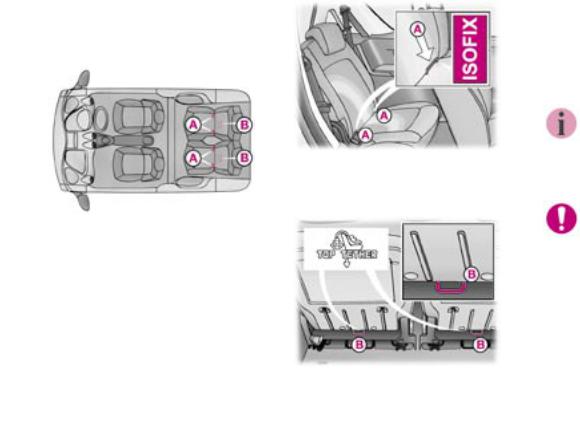
104 - Comfort
"ISOFIX" MOUNTINGS
Your vehicle has been approved in accordance with the new ISOFIX regulation.
The seats*, represented below, are fitted with regulation ISOFIX mountings:
 01-10-2005
01-10-2005
These are three rings for each seat:
-two lower rings A, located between the vehicle seat back and cushion, indicated by a label,
-an upper ring B, referred to as the
TOP TETHER, indicated by a label.
This ISOFIX mounting system guarantees you fast, reliable and safe fitting of the child seat in your vehicle.
The ISOFIX child seats are fitted with two locks which are secured easily on these lower rings A.
Some also have an upper strap which is attached to the upper ring B.
To attach this strap, raise the vehicle seat's head restraint then pass the hook between its rods. Then fix
the hook on the upper ring B and tighten the upper strap.
The incorrect installation of a child seat in a vehicle compromises the child's protection in the event of an accident.
For information regarding the ISOFIX child seats which can be installed in your vehicle, consult the summary table for the location of the ISOFIX child seats.
* According to version.
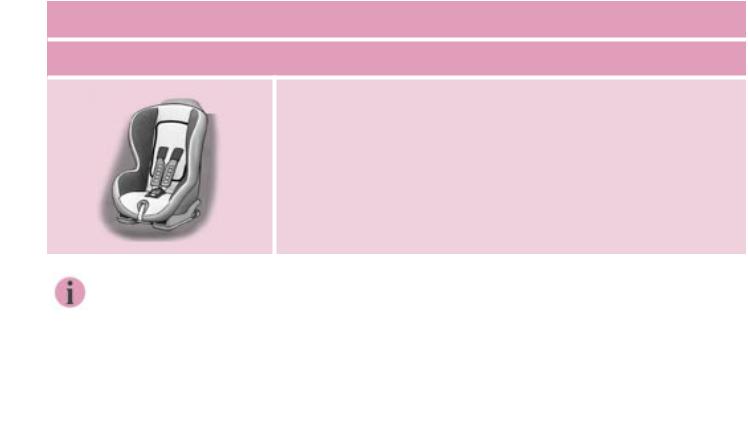
Comfort - 105
ISOFIX CHILD SEAT RECOMMENDED BY PEUGEOT
RÖMER Duo (size category B1)
Group 1: from 9 to 18 kg
Installed in the forward facing position.
Fitted with an upper strap.
Three seat body angles: sitting, reclining, lying.
This child seat can also be used on seats which are not fitted with ISOFIX mountings. In this case, it must be attached to the vehicle seat using the three point seat belt.
Follow the instructions for fitting the child seat given in the seat manufacturer's installation guide.
 01-10-2005
01-10-2005

106 - Comfort
SUMMARY TABLE FOR THE INSTALLATION OF ISOFIX CHILD SEATS
In accordance with the European regulation (ECE 16), this table indicates the options for the installation of ISOFIX child seats on the vehicle seats fitted with ISOFIX mountings.
In the case of the universal and semi-universal ISOFIX child seats, the child seat's ISOFIX size category, determined by a letter from A to G, is indicated on the child seat next to the ISOFIX logo.
|
|
|
|
Weight of the child/indicative age |
|
|
|
|||
|
Less than 10 kg |
Less than 10 kg |
|
|
|
|
|
|||
|
|
(group0) |
|
|
From 9 to 18 kg |
|
||||
|
|
(group 0) |
|
|
|
|
||||
|
|
Less than 13 kg |
|
(group 1) |
|
|
||||
|
Up to approx. |
|
|
|
||||||
|
|
(group 0+) |
|
|
From 1 to 3 years approx |
|
||||
|
|
6 months |
|
|
|
|
||||
|
|
Up to approx. 1 year |
|
|
|
|
|
|||
|
|
|
|
|
|
|
|
|||
Type of ISOFIX child seat |
Infant car seat* |
|
"rear facing" |
|
"rear facing" |
"forward facing" |
||||
ISOFIX size category |
F |
G |
C |
D |
E |
C |
D |
A |
B |
B1 |
Universal and semi-universal |
|
|
|
|
|
|
|
|
IUF |
|
ISOFIX child seats which can be |
|
IL-SU |
|
IL-SU |
|
|
IL-SU |
|
|
|
|
|
|
|
|
IL-SU |
|
||||
installed on the rear seats |
|
|
|
|
|
|
|
|
|
|
|
|
|
|
|
|
|
|
|
|
|
IUF: seat suitable for the installation of an Isofix Universal seat, "Forward facing" and secured using the "Top Tether" upper strap.
 01-10-2005
01-10-2005
IL-SU: seat suitable for the installation an Isofix Semi-Universal seat which is:
-"rear facing",
-"forward facing" fitted with a stay,
-an infant car seat which is secured using the "Top Tether" upper strap or which is fitted with a stay.
For the securing of the "Top Tether" upper strap, refer to the "Isofix Mountings" section.
*The ISOFIX infant car seat is fixed to the lower rings of an ISOFIX seat and occupies the two rear seats.
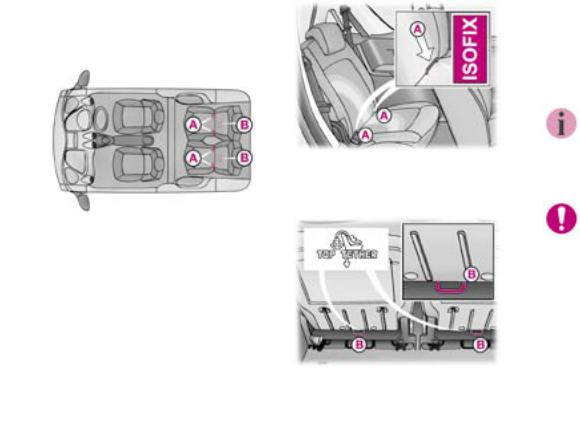
104 - Comfort
"ISOFIX" MOUNTINGS
Your vehicle has been approved in accordance with the new ISOFIX regulation.
The seats*, represented below, are fitted with regulation ISOFIX mountings:
 01-10-2005
01-10-2005
These are three rings for each seat:
-two lower rings A, located between the vehicle seat back and cushion, indicated by a label,
-an upper ring B, referred to as the
TOP TETHER, indicated by a label.
This ISOFIX mounting system guarantees you fast, reliable and safe fitting of the child seat in your vehicle.
The ISOFIX child seats are fitted with two locks which are secured easily on these lower rings A.
Some also have an upper strap which is attached to the upper ring B.
To attach this strap, raise the vehicle seat's head restraint then pass the hook between its rods. Then fix
the hook on the upper ring B and tighten the upper strap.
The incorrect installation of a child seat in a vehicle compromises the child's protection in the event of an accident.
For information regarding the ISOFIX child seats which can be installed in your vehicle, consult the summary table for the location of the ISOFIX child seats.
* According to version.
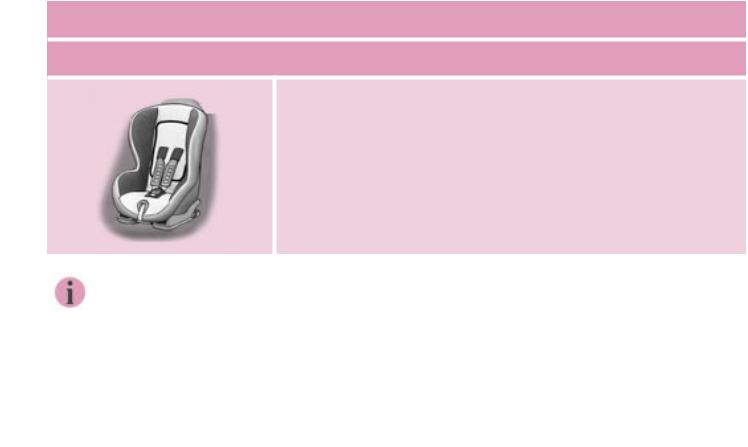
Comfort - 105
ISOFIX CHILD SEAT RECOMMENDED BY PEUGEOT
RÖMER Duo (size category B1)
Group 1: from 9 to 18 kg
Installed in the forward facing position.
Fitted with an upper strap.
Three seat body angles: sitting, reclining, lying.
This child seat can also be used on seats which are not fitted with ISOFIX mountings. In this case, it must be attached to the vehicle seat using the three point seat belt.
Follow the instructions for fitting the child seat given in the seat manufacturer's installation guide.
 01-10-2005
01-10-2005

106 - Comfort
SUMMARY TABLE FOR THE INSTALLATION OF ISOFIX CHILD SEATS
In accordance with the European regulation (ECE 16), this table indicates the options for the installation of ISOFIX child seats on the vehicle seats fitted with ISOFIX mountings.
In the case of the universal and semi-universal ISOFIX child seats, the child seat's ISOFIX size category, determined by a letter from A to G, is indicated on the child seat next to the ISOFIX logo.
|
|
|
|
Weight of the child/indicative age |
|
|
|
|||
|
Less than 10 kg |
Less than 10 kg |
|
|
|
|
|
|||
|
|
(group0) |
|
|
From 9 to 18 kg |
|
||||
|
|
(group 0) |
|
|
|
|
||||
|
|
Less than 13 kg |
|
(group 1) |
|
|
||||
|
Up to approx. |
|
|
|
||||||
|
|
(group 0+) |
|
|
From 1 to 3 years approx |
|
||||
|
|
6 months |
|
|
|
|
||||
|
|
Up to approx. 1 year |
|
|
|
|
|
|||
|
|
|
|
|
|
|
|
|||
Type of ISOFIX child seat |
Infant car seat* |
|
"rear facing" |
|
"rear facing" |
"forward facing" |
||||
ISOFIX size category |
F |
G |
C |
D |
E |
C |
D |
A |
B |
B1 |
Universal and semi-universal |
|
|
|
|
|
|
|
|
IUF |
|
ISOFIX child seats which can be |
|
IL-SU |
|
IL-SU |
|
|
IL-SU |
|
|
|
|
|
|
|
|
IL-SU |
|
||||
installed on the rear seats |
|
|
|
|
|
|
|
|
|
|
|
|
|
|
|
|
|
|
|
|
|
IUF: seat suitable for the installation of an Isofix Universal seat, "Forward facing" and secured using the "Top Tether" upper strap.
 01-10-2005
01-10-2005
IL-SU: seat suitable for the installation an Isofix Semi-Universal seat which is:
-"rear facing",
-"forward facing" fitted with a stay,
-an infant car seat which is secured using the "Top Tether" upper strap or which is fitted with a stay.
For the securing of the "Top Tether" upper strap, refer to the "Isofix Mountings" section.
*The ISOFIX infant car seat is fixed to the lower rings of an ISOFIX seat and occupies the two rear seats.
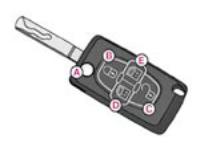
THE KEYS
The keys allow you to switch on the ignition and to independently operate the locks on the driver's door the fuel filler cap and the passenger air bag disarming switch.
Folding/unfolding the key
To fold the key, press button A then fold the key into the casing of the remote control.
To unfold the key, press button A.
 01-10-2005
01-10-2005
Central locking
Version with normal locking
From the driver's door, the keys allow you to lock or unlock the doors and tailgate.
If one of the doors or the tailgate is open, the central locking does not work.
Version with deadlocking
Turning the key a second time within a maximum of five seconds changes the deadlocking of the vehicle to normal locking.
The remote control performs the same functions at a distance.
The remote control
Version with normal locking
Press button B to lock the vehicle.
This is confirmed by fixed lighting of the direction indicators for approximately two seconds.
Unlocking
Press button C to unlock the vehicle.
This is confirmed by rapid flashing of the direction indicators.
When the vehicle is locked, if unlocking is activated inadvertently, without the doors being opened within 30 seconds, the vehicle will lock automatically.
Accesses - 107
Opening/Closing the "Sesame" doors
Pressing button D or E opens or closes the left or right door.
This press unlocks the vehicle before opening the corresponding door.
A second press stops the movement of the corresponding door.
A third press reverses the movement of the corresponding door.
Version with deadlocking
Warning: deadlocking renders the internal and external door controls inoperative.
Never leave anyone inside the vehicle when it is deadlocked.
Pressing button B deadlocks the vehicle.
This is confirmed by fixed lighting of the direction indicators for approximately two seconds.
A second press on button B within five seconds following deadlocking, changes the deadlocking to normal locking.
This is confirmed by fixed lighting of the direction indicators for approximately two seconds.
If the deadlocking is operated from inside the vehicle, it will change to normal locking when the vehicle is started.
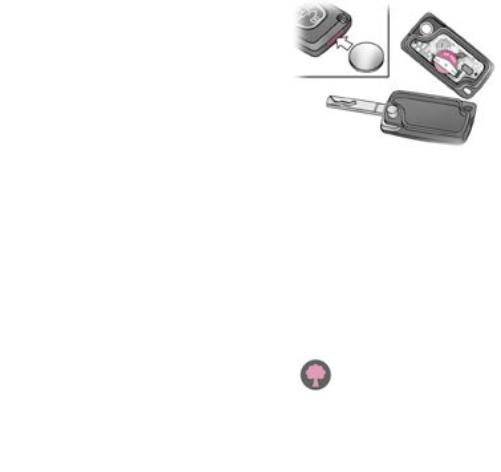
108 - Accesses
Locating your vehicle
To locate your vehicle, if you have locked it, in a car park:
Fpress button B, the courtesy lights come on and the direction indicators flash for a few seconds.
Key in ignition
A message on the multi-function display, accompanied by a buzzer on opening the driver's door, indicates that the key has been left in the ignition.
 01-10-2005
01-10-2005
Changing the battery of the remote control
Battery ref.: CR1620/3 volts.
The information "battery flat" is given by an audible signal, accompanied by a message on the multifunction display.
To replace the battery, unclip the casing using a coin at the ring.
If the remote control does not work after the battery has been changed, re-programme the remote control.
Do not discard the remote control batteries, they contain metals which are harmful to the environment.
Take them to a PEUGEOT dealership, or to any other approved collection point.
Programming the remote control
Following changing of the remote control battery or disconnection of the vehicle battery, the remote control must be reprogrammed.
F Wait at least one minute before using the remote control.
FSwitch on the ignition.
FPress button B or C for at least five seconds within the next ten seconds.
FSwitch off the ignition.
FWait at least one minute before using the remote control.
The remote control is now working again.
ELECTRONIC ENGINE IMMOBILISER
This locks the engine management system as soon as the ignition has been switched off and therefore prevents starting of the vehicle by anyone who does not have the key.
The ignition key has an electronic chip which has a special code. When the ignition is switched on, the code is recognised and starting is possible.
If the system does not function correctly, contact a PEUGEOT dealer as soon as possible.
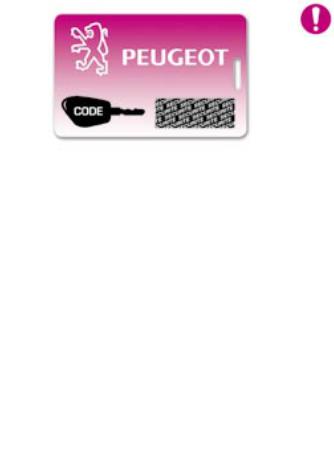
CONFIDENTIAL CARD
The confidential card contains the identification code necessary for any work carried out by a PEUGEOT dealer on the electronic immobiliser system. This code is hidden by a film, which should be removed only if necessary.
Keep your card in a safe place, never inside the vehicle.
Make a careful note of the number on each key. The key number is coded on the label attached to the key.
If the keys are lost, your PEUGEOT dealer can rapidly supply you with new keys.
The high frequency remote control is a sensitive system; do not operate it while it is in your pocket as there is a possibility that it may unlock your vehicle, without you being aware of it.
The remote control does not operate when the key is in the ignition, even when the ignition is switched off, except for reprogramming.
Do not operate the deadlocking function if there is anyone inside the vehicle.
Driving with the doors locked may make access to the passenger compartment by the emergency services more difficult in an emergency.
As a safety precaution (with children on board), remove the ignition key when you leave the vehicle, even for a short time.
Do not repeatedly press the button of your remote control out of range of your vehicle. You run the risk of stopping it from working and the remote control would have to be reprogrammed.
Accesses - 109
When purchasing a second-hand vehicle:
-ensure that you are given the confidential card;
-have the key codes memorised by a PEUGEOT dealer, to ensure that the keys in your possession are the only ones which can start the vehicle.
Do not make any modifications to the electronic engine immobiliser system.
 01-10-2005
01-10-2005
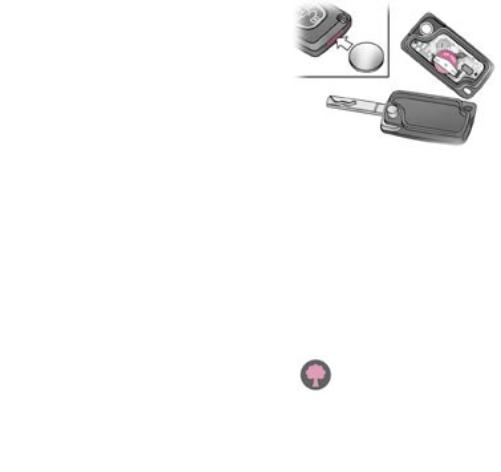
108 - Accesses
Locating your vehicle
To locate your vehicle, if you have locked it, in a car park:
Fpress button B, the courtesy lights come on and the direction indicators flash for a few seconds.
Key in ignition
A message on the multi-function display, accompanied by a buzzer on opening the driver's door, indicates that the key has been left in the ignition.
 01-10-2005
01-10-2005
Changing the battery of the remote control
Battery ref.: CR1620/3 volts.
The information "battery flat" is given by an audible signal, accompanied by a message on the multifunction display.
To replace the battery, unclip the casing using a coin at the ring.
If the remote control does not work after the battery has been changed, re-programme the remote control.
Do not discard the remote control batteries, they contain metals which are harmful to the environment.
Take them to a PEUGEOT dealership, or to any other approved collection point.
Programming the remote control
Following changing of the remote control battery or disconnection of the vehicle battery, the remote control must be reprogrammed.
F Wait at least one minute before using the remote control.
FSwitch on the ignition.
FPress button B or C for at least five seconds within the next ten seconds.
FSwitch off the ignition.
FWait at least one minute before using the remote control.
The remote control is now working again.
ELECTRONIC ENGINE IMMOBILISER
This locks the engine management system as soon as the ignition has been switched off and therefore prevents starting of the vehicle by anyone who does not have the key.
The ignition key has an electronic chip which has a special code. When the ignition is switched on, the code is recognised and starting is possible.
If the system does not function correctly, contact a PEUGEOT dealer as soon as possible.
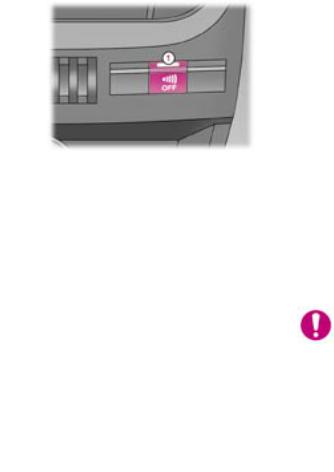
110 - Accesses
ALARM*
The alarm offers two types of protection.
-external; the alarm sounds if one of the doors, the bonnet or the tailgate is opened,
-internal; the alarm sounds if there is air movement in the passenger compartment (a broken window or movement within the car).
The alarm also has an anti-tamper function.
If there is an attempt to tamper with the following equipment:
-the wires to the siren or the control unit, the siren sounds accompanied by flashing of the direction indicators.
-the battery, the siren sounds.
 01-10-2005
01-10-2005
Complete setting and disarming of the alarm
Complete setting of the alarm
Switch off the ignition and get out of the vehicle.
Lock or deadlock the vehicle.
The direction indicators light for two seconds.
The red indicator light on the switch 1 flashes once a second.
5 seconds later, external protection is set.
45 seconds later, internal protection is set.
Note: when the alarm is triggered, the siren sounds for thirty seconds. However, after the siren stops, the alarm remains set.
When the alarm is set, if a door, the tailgate or the bonnet is not closed correctly, the siren sounds for
a moment. If the vehicle is closed correctly in the following 45 seconds, the alarm is set. In all cases, the alarm is set after 45 seconds.
Complete disarming of the alarm
Press the unlocking button on the remote control.
The direction indicators flash for two seconds.
The red indicator light on the switch 1 goes out.
Note: if the indicator light continues to flash after de-activation of the alarm, it is a sign that the alarm has been triggered during your absence. The flashing will stop when the ignition is switched on.
Automatic setting*
The alarm is set automatically 2 minutes after the last door or the boot is closed.
To prevent the alarm being triggered when a door or the boot is opened, the remote control unlocking button must be pressed again.
Locking the vehicle without alarm
To lock the vehicle without activating the alarm (for example when washing), insert the key in the lock, then lock it.
* According to country

Selection of the type of protection
To set the alarm to external protection only
If you want to leave a window partially open, or a pet inside the vehicle, you need to select external protection only:
-switch off the ignition,
-within the next ten seconds, press the control button 1 until the warning light comes on continuously,
-get out of the vehicle,
-lock or deadlock the vehicle,
-the direction indicators light for two seconds,
-the red indicator light on the switch 1 flashes once a second.
To de-activate external protection only
Press the unlocking button on the remote control.
The direction indicators flash for two seconds.
The red indicator light on the switch 1 goes out.
Accesses - 111
Remote control failure
Unlock the doors using the key.
Open the door.
The alarm is triggered.
Switch on the ignition.
The electronic engine immobiliser system recognises the key.
The siren stops and the alarm is disarmed.
Work on the battery
The alarm must not be set when the battery is disconnected. Otherwise, the siren will sound.
After reconnecting the battery:
-lock or deadlock, then unlock the vehicle using the remote control,
-the alarm will be operational again the next time the vehicle is locked or deadlocked.
Do not make any modifications to the alarm system, this could result in malfunctions.
 01-10-2005
01-10-2005
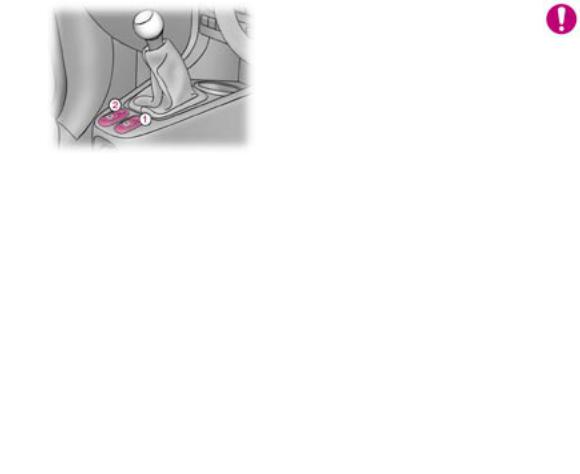
112 - Accesses
ELECTRIC WINDOWS
1 - Driver's electric window switch.
2 - Passenger electric window switch.
You have two options:
- Manual operation:
Press or pull control 1 gently. The window stops as soon as the control is released.
- Automatic operation:
Press or pull control 1 fully. The window opens or closes completely when the control is released. Pressing the control again stops the movement of the window.
 01-10-2005
01-10-2005
Notes:
The electric window controls are not active when the door concerned is open.
The movement of a window stops if the door is opened. A second action on the electric window control will only be taken into account when the door is closed.
The electrical functions of the electric windows are deactivated approximately one minute after the ignition is switched off.
Safety auto-reverse
When the window rises and meets an obstacle, it stops and partially lowers again.
Note:
In the case of unwanted opening of the window on closing or if the window will not rise, lower it completely and raise it again immediately, by pulling the control until the window closes completely. Continue to press the control for approximately one second after closing.
Always remove the key from the ignition when leaving the vehicle, even for a short time.
In the event of contact when operating the windows, you must reverse the movement of the window. To do this, press the control concerned.
When the driver operates the passenger window controls, he must ensure that no one is preventing correct closing of the window.
The driver must ensure that passengers use the electric windows correctly.
Be aware of children when operating the windows.
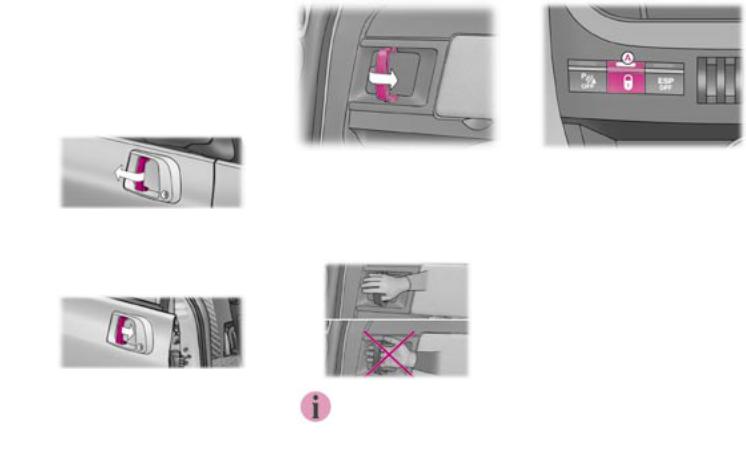
THE "SESAME" DOORS
The exterior and interior handles only permit triggering of the electric movement of the door when it is fully closed or fully open.
Opening and closing of the doors is accompanied by an audible signal.
Opening from outside
Using your hand, tilt the handle towards the rear of the vehicle and remove your hand from the handle when the electric movement of the door begins.
Closing from outside
Give a firm, fast push forwards on the handle, without guiding the door, to trigger the electric movement of the door.
 01-10-2005
01-10-2005
Opening/Closing from inside
The opening and closing operates in the same way as from outside.
None of the door opening switches function when the vehicle is deadlocked.
To open using the interior handle: tilt the handle, with the palm of your hand towards the door.
Accesses - 113
Locking/Unlocking from inside
Press button A, the red warning light comes on when the vehicle is locked and switches off when it is unlocked.
This locks/unlocks the doors and the tailgate.
If the vehicle is locked or deadlocked from outside, the red warning light flashes and button A does not function. In this case, use the key or the remote control for unlocking.
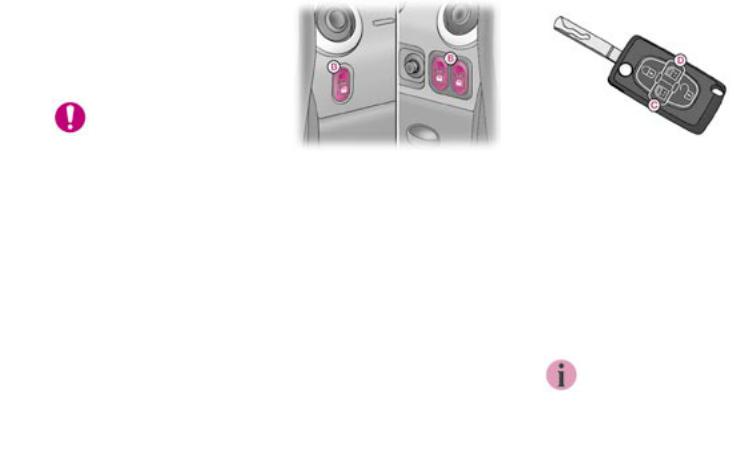
114 - Accesses
Automatic central locking
The doors can lock automatically when you are driving (at a speed of more than 6 mph (10 km/h)).
You can activate or deactivate this function.
Driving with the doors locked may make access to the passenger compartment by the emergency services more difficult in an emergency.
Activation
With the ignition on, press and hold button A.
Activation of the function is accompanied by an audible signal and a message on the multifunction display.
Deactivation
With the ignition on, press and hold button A.
Deactivation of the function is accompanied by an audible signal.
"Door open" alert
When the vehicle is moving, a diagram or a message locating the door on the multifunction display, accompanied by a permanent audible signal and flashing of the courtesy light warn you that a door or the boot is not properly closed.
 01-10-2005
01-10-2005
Opening/Closing from the front
Press switch B to open or close the corresponding door.
Choosing the movement of the door using the switches:
-pull è opens the door,
-push è closes,
-second press è stops the movement,
-the switches do not function above
3 mph (5 km/h).
Opening/Closing using the remote control
Press button C or D to open or close the left or right door.
The opening and closing of the door is accompanied by an audible signal.
2nd press on button C or D during opening/closing è interruption of the movement.
3rd press on button C or D
è movement of the door in the opposite direction.
You are advised to use the remote control or the switches as much as possible.
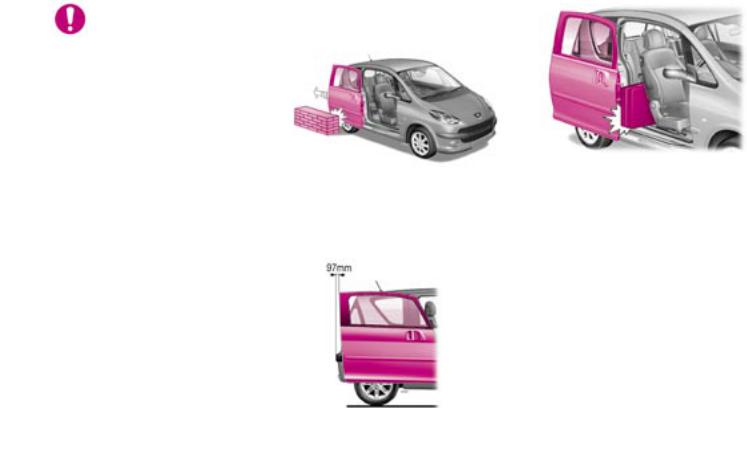
General recommendations
Always check that it is safe to operate the door and be sure, in particular, not to leave children or animals near the door controls without supervision.
When opening the door, with the window open, ensure that no person, animal or object is hanging through the window.
Before any opening or closing and during any movement of the doors, ensure that no person, animal or object is preventing the required manoeuvre, either inside or outside the vehicle.
It is imperative that the doors are operated only when the vehicle is stationary.
For your safety and for that of your passengers, you are strongly advised not to drive with a door open. The flashing of the courtesy light + audible warning + "door open" message are there to remind you.
Lock your vehicle when using an automatic carwash.
 01-10-2005
01-10-2005
The doors and the overall dimensions of the vehicle
When open, a door exceeds the width of the exterior mirror by 8 mm, be sure to take this into account when you park alongside a wall, a post or a high kerb...
When open, a door never protrudes beyond the rear bumper.
Accesses - 115
Safety/Obstacle detection
The obstacle detection system is triggered when an obstacle of a certain physical resistance hinders the movement of the door.
•If an obstacle is detected while the door is closing, the door stops then opens fully.
•If an obstacle is detected while the door is opening, the door stops. When you have removed the obstacle, complete or restart the action using buttons C or D on the remote control or the switches B.
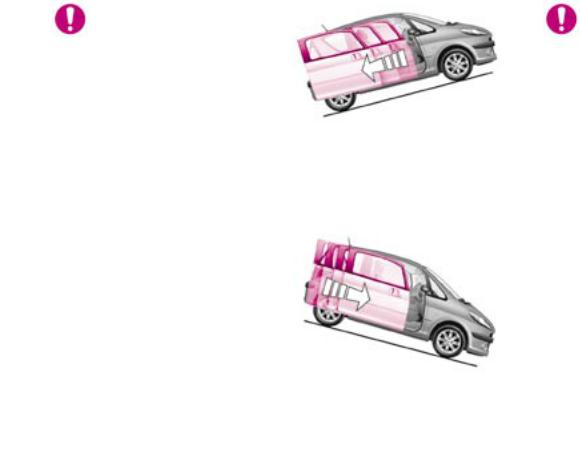
116 - Accesses
Before any opening or closing and during any movement of the doors, ensure that no person, animal or
object is preventing the required manoeuvre, either inside or outside the vehicle. If this advice is not followed, injuries or damage may occur if a part of the body or an object is trapped or caught.
Electric closing and opening of the doors is not possible above 3 mph (5 km/h):
•If you set off with the door(s) open, you must slow down to below the threshold of 3 mph (5 km/h) in order to close the door(s).
•Any attempt to open a door electrically using the interior handle, while driving, results in the door opening partially and, as a safety measure, locking in this position immediately. Flashing of the courtesy light + audible warning + "door open" message accompany this situation. In order to release the door and be able to operate it again, you must slow down to below the threshold of 3 mph (5 km/h) again.
Behaviour in the case of a steep slope
It is possible to open and close the doors electrically up to a gradient of 20 %.
 01-10-2005
01-10-2005
However, if your vehicle is on a slope, with the front of the vehicle facing up, open the door with care. The door may open more quickly due to the incline of the ground.
However, if your vehicle is on a slope, with the front of the vehicle facing down, the door may not stay open and may close again sharply with the risk of injury.
In the case of a steep slope, the door may be driven by its own weight and as a consequence may open or close sharply.
Therefore:
•There would not be time for operation of one of the electric controls to be taken into account.
•There would not be time for the obstacle detection system to be triggered.
Take care not to leave the vehicle on a steep slope with the door(s) open without supervision. If this advice is not followed, injuries or damage may occur if a part of the body or an object is trapped or caught.
In the event of an impact
The electric controls are deactivated in the event of an impact. Manual opening and closing is still possible.
Special features of operation
With the ignition off,
•doors open, power consuming equipment on (radio, lights…),
or
•doors in an intermediate position (door neither fully open nor fully closed).
After 30 minutes, the vehicle automatically switches to energy economy mode.
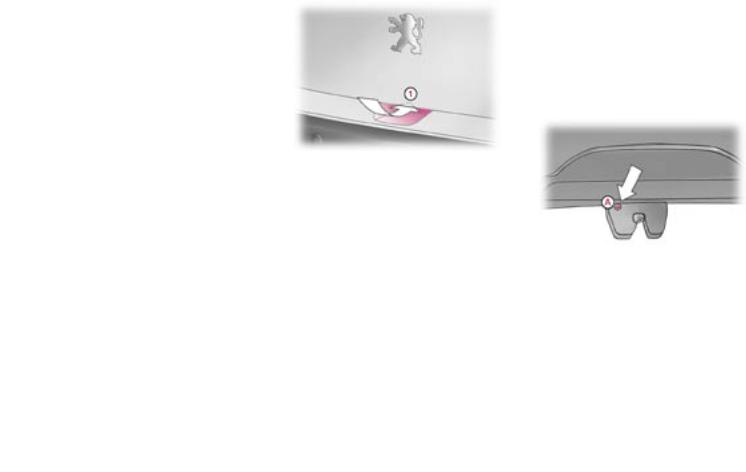
In this case, or following reconnection of the battery, with the doors open, it may be necessary to close the doors manually, in order to reinitialise them, and start the engine.
When the door has stopped in an intermediate position (neither fully open nor fully closed), only the remote control or the switches permit electric operation of the door.
When closing requests are made when the door is in a partially open position, the door may open slightly before closing.
When closing a door electrically when the battery is low, you are advised to guide the door manually. Recharge the battery as soon as possible.
If the electric controls (remote control or switches) no longer operate, reinitialise the doors(s) as follows:
1.Start the engine.
2.Manually open the door(s) fully.
3.Close the door(s) fully.
On completion of this procedure, electric operation of the doors is restored.
However, if a problem persists following this procedure, contact a PEUGEOT dealer.
TAILGATE
Simultaneous locking or unlocking of the tailgate and the doors
The tailgate is locked or unlocked by the remote control or the driver's door lock.
To open, press the control 1 and lift the tailgate.
Note: the tailgate locks automatically when the vehicle speed reaches 6 mph (10 km/h). It unlocks when one of the doors is opened if the speed is below 6 mph (10 km/h) or when the central locking button on the centre console is pressed.
Accesses - 117
"Tailgate open" warning
With the engine running, an audible signal and a diagram or a message displayed briefly on the multifunction screen warn you that the tailgate is not properly closed.
Tailgate release
This enables the tailgate to be unlocked in the event of a central locking fault.
-Fold back the rear seats to gain access to the lock from inside the boot,
-Insert a small screwdriver into hole A of the lock to unlock the tailgate.
 01-10-2005
01-10-2005
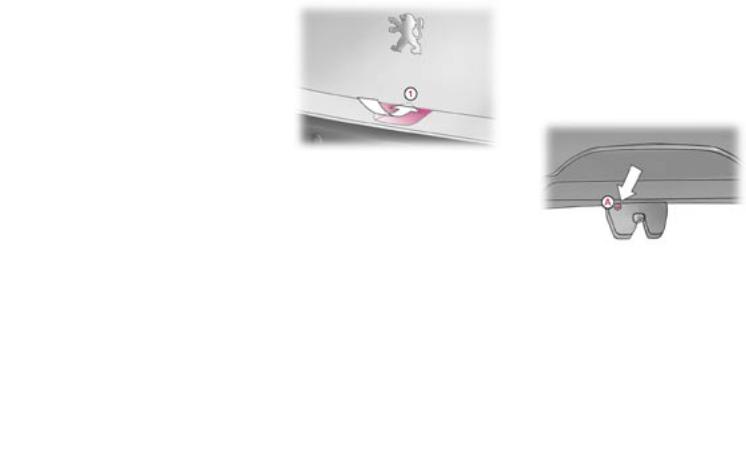
In this case, or following reconnection of the battery, with the doors open, it may be necessary to close the doors manually, in order to reinitialise them, and start the engine.
When the door has stopped in an intermediate position (neither fully open nor fully closed), only the remote control or the switches permit electric operation of the door.
When closing requests are made when the door is in a partially open position, the door may open slightly before closing.
When closing a door electrically when the battery is low, you are advised to guide the door manually. Recharge the battery as soon as possible.
If the electric controls (remote control or switches) no longer operate, reinitialise the doors(s) as follows:
1.Start the engine.
2.Manually open the door(s) fully.
3.Close the door(s) fully.
On completion of this procedure, electric operation of the doors is restored.
However, if a problem persists following this procedure, contact a PEUGEOT dealer.
TAILGATE
Simultaneous locking or unlocking of the tailgate and the doors
The tailgate is locked or unlocked by the remote control or the driver's door lock.
To open, press the control 1 and lift the tailgate.
Note: the tailgate locks automatically when the vehicle speed reaches 6 mph (10 km/h). It unlocks when one of the doors is opened if the speed is below 6 mph (10 km/h) or when the central locking button on the centre console is pressed.
Accesses - 117
"Tailgate open" warning
With the engine running, an audible signal and a diagram or a message displayed briefly on the multifunction screen warn you that the tailgate is not properly closed.
Tailgate release
This enables the tailgate to be unlocked in the event of a central locking fault.
-Fold back the rear seats to gain access to the lock from inside the boot,
-Insert a small screwdriver into hole A of the lock to unlock the tailgate.
 01-10-2005
01-10-2005

118 - Accesses
PANORAMIC SUNROOF
This sunroof is a panoramic assembly which provides maximum brightness and visibility in the passenger compartment.
It consists of two parts:
-a fixed rear part,
-a moving front part.
Each part has an independent manual shutter.
The sunroof is controlled electrically by a dial with 9 opening positions.
To open: turn the dial to the left (nine possible settings).
Once the roof is open, the front shutter cannot be closed.
To close: return the control to the initial position "O".
Safety auto-reverse
When the roof meets an obstacle while closing, it partially opens again.
Following reconnection of the battery, in the event of a malfunction or in the event of unwanted opening of the roof on closing, the safety autoreverse must be reinitialised:
-place the dial in the fully closed position (initial position "O"),
-press the dial immediately,
-continue to press until the roof is fully closed.
The safety auto-reverse function is not operational during this operation.
Always remove the ignition key when leaving the vehicle, even for a short time.
In the event of contact during operation of the roof, the movement of the roof must be reversed. To do this, operate the control concerned.
When the driver operates the roof control, he must ensure that no one is preventing the roof from closing correctly.
The driver must ensure that the passengers use the sunroof correctly.
Be aware of children when operating the roof.
Check that the slides are clean to ensure that the sunroof slides correctly.
 01-10-2005
01-10-2005
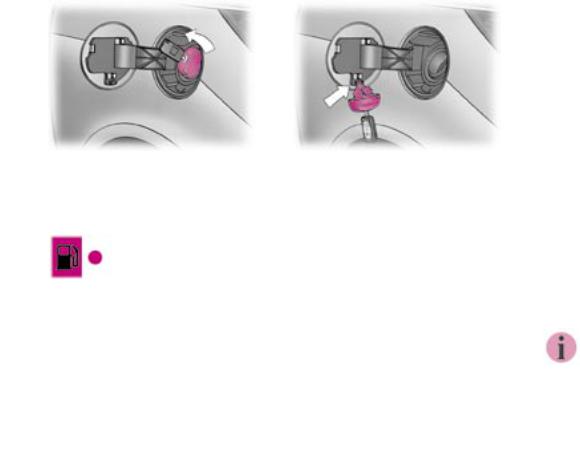
Accesses - 119
FILLING THE FUEL TANK
Low fuel level
When the tank's minimum level is reached, this warning light comes on, accompanied by a message on the multifunction display.
You have enough fuel left to cover approximately 30 miles (50 km).
The tank must be filled with fuel with the engine off.
FOpen the fuel filler flap.
FInsert the key then turn it to the left.
FRemove the cap and attach it to the clip located on the inside of the flap.
A label on the inside of the flap indicates which type of fuel to use.
If you fill your tank, do not continue after the third cut-off of the pump nozzle. This could result in vehicle malfunctions.
The capacity of the tank is approximately 9 gallons (40 litres).
F After filling the tank, lock the cap and close the flap.
The electric opening of the left-hand door is inhibited when the fuel filler flap is open.
The key cannot be removed from the cap's lock until the cap is refitted on the tank.
 01-10-2005
01-10-2005
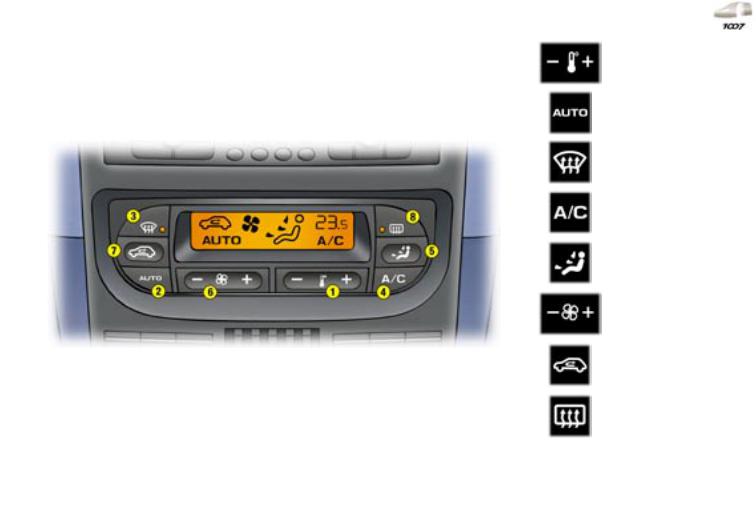
12 - Familiarisation
|
1. |
Temperature |
|
|
adjustment. |
|
2. |
Automatic comfort |
|
|
programme. |
|
3. |
Automatic visibility |
|
|
programme. |
|
4. |
Air conditioning on/ |
|
|
off. |
|
5. |
Air distribution |
|
|
adjustment. |
|
6. |
Air flow adjustment. |
|
7. |
Air intake/Air |
AUTOMATIC AIR CONDITIONING |
: 90 |
recirculation. |
|
||
|
8. |
Rear screen and |
|
|
exterior mirrors |
|
|
demisting. |
 01-10-2005
01-10-2005

120 - Visibility
THE LIGHTS STALK
Front and rear lights
Selection is by turning ring A.
Lights off
Side lights
Dipped/main beam headlamps
Automatic switching on of lights
 01-10-2005
01-10-2005
Dipped/Main beam change
Pull the stalk fully towards you.
Lights on
With the ignition off, when the driver's door is opened, if you have left your lights on, a buzzer sounds, accompanied by a message on the multifunction display.
Front fog lamps and rear fog lamp
Rotate the ring forwards to switch on and backwards to switch off. The status is displayed by the indicator light on the instrument panel.
Vehicles fitted with a rear fog lamp (ring B)
Rear fog lamp
This can only operate with the dipped and main beam headlamps.
Vehicles fitted with front fog lamps and a rear fog lamp (ring C)
Front fog lamps (1st rotation of the ring forwards)
These operate with the side lights and dipped headlamps.
Notes:
When the main beam headlamps are switched on, the front fog lamps are switched off.
When the lights are switched off automatically, the front fog lamps and the side lights will remain on (turn the ring backwards to switch the fog lamps off).
Front fog lamps and rear fog lamp (2nd rotation of the ring forwards)
Note: to switch off the rear fog lamp and the front fog lamps, turn the ring backwards twice in succession.

In good or rainy weather, both day and night, the front fog lamps and the rear fog lamps are dazzling and are prohibited.
Do not forget to switch them off when they are no longer needed.
Follow-me-home lighting
In poor light or at night, if you leave your vehicle, the side lights and dipped headlamps can be left on for approximately one minute.
To do this:
-turn the key to the STOP position,
-place the lights stalk in position 0,
-within the next minute, flash the headlamps,
-get out of the vehicle and lock it.
Direction indicators (flashers)
Left: downwards.
Right: upwards.
AUTOMATIC SWITCHING ON OF LIGHTS
The side lights and dipped beam headlamps switch on automatically if the light is poor and when the windscreen wipers operate continuously. They switch off when the light becomes bright enough or the windscreen wipers are switched off.
In foggy weather or in snow, the brightness sensor can detect sufficient light, the lights will not come on automatically.
This function is active when the vehicle is supplied to the customer.
To disarm or activate the function:
-Place the key in the accessories position (1st notch),
-Place the lights stalk in position 0,
-Press the end of the lights stalk for more than two seconds.
Do not cover the brightness sensor, coupled with the rain sensor, located in the centre of the windscreen, behind the interior mirror. It is used for automatic switching on of the lights.
Visibility - 121
Operating check
Activation
The activated function is accompanied by an audible signal and a message on the multifunction display.
Disarming
The disarmed function is accompanied by an audible signal and a message on the multifunction display.
When the driver uses the manual lighting controls, the function is disarmed temporarily.
If the brightness sensor does not function correctly, the lights come on accompanied by an audible signal and a message on the multifunction display.
Contact a PEUGEOT dealer.
 01-10-2005
01-10-2005
